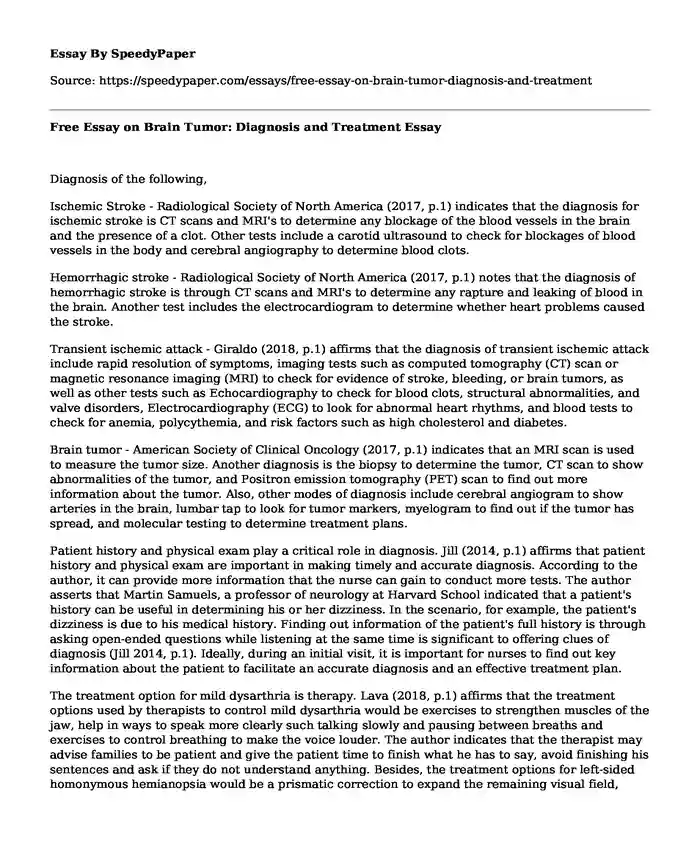
| Type of paper: | Research paper |
| Categories: | Medicine Healthcare |
| Pages: | 3 |
| Wordcount: | 666 words |
Diagnosis of the following,
Ischemic Stroke - Radiological Society of North America (2017, p.1) indicates that the diagnosis for ischemic stroke is CT scans and MRI's to determine any blockage of the blood vessels in the brain and the presence of a clot. Other tests include a carotid ultrasound to check for blockages of blood vessels in the body and cerebral angiography to determine blood clots.
Hemorrhagic stroke - Radiological Society of North America (2017, p.1) notes that the diagnosis of hemorrhagic stroke is through CT scans and MRI's to determine any rapture and leaking of blood in the brain. Another test includes the electrocardiogram to determine whether heart problems caused the stroke.
Transient ischemic attack - Giraldo (2018, p.1) affirms that the diagnosis of transient ischemic attack include rapid resolution of symptoms, imaging tests such as computed tomography (CT) scan or magnetic resonance imaging (MRI) to check for evidence of stroke, bleeding, or brain tumors, as well as other tests such as Echocardiography to check for blood clots, structural abnormalities, and valve disorders, Electrocardiography (ECG) to look for abnormal heart rhythms, and blood tests to check for anemia, polycythemia, and risk factors such as high cholesterol and diabetes.
Brain tumor - American Society of Clinical Oncology (2017, p.1) indicates that an MRI scan is used to measure the tumor size. Another diagnosis is the biopsy to determine the tumor, CT scan to show abnormalities of the tumor, and Positron emission tomography (PET) scan to find out more information about the tumor. Also, other modes of diagnosis include cerebral angiogram to show arteries in the brain, lumbar tap to look for tumor markers, myelogram to find out if the tumor has spread, and molecular testing to determine treatment plans.
Patient history and physical exam play a critical role in diagnosis. Jill (2014, p.1) affirms that patient history and physical exam are important in making timely and accurate diagnosis. According to the author, it can provide more information that the nurse can gain to conduct more tests. The author asserts that Martin Samuels, a professor of neurology at Harvard School indicated that a patient's history can be useful in determining his or her dizziness. In the scenario, for example, the patient's dizziness is due to his medical history. Finding out information of the patient's full history is through asking open-ended questions while listening at the same time is significant to offering clues of diagnosis (Jill 2014, p.1). Ideally, during an initial visit, it is important for nurses to find out key information about the patient to facilitate an accurate diagnosis and an effective treatment plan.
The treatment option for mild dysarthria is therapy. Lava (2018, p.1) affirms that the treatment options used by therapists to control mild dysarthria would be exercises to strengthen muscles of the jaw, help in ways to speak more clearly such talking slowly and pausing between breaths and exercises to control breathing to make the voice louder. The author indicates that the therapist may advise families to be patient and give the patient time to finish what he has to say, avoid finishing his sentences and ask if they do not understand anything. Besides, the treatment options for left-sided homonymous hemianopsia would be a prismatic correction to expand the remaining visual field, vision restoration therapy to improve vision on the left side, and compensatory training to improve visual abilities (Goodwin 2014, p.1).
References
American Society of Clinical Oncology. (2017). Brain Tumor: Diagnosis. Cancer.net. Retrieved from https://www.cancer.net/cancer-types/brain-tumor/diagnosis
Giraldo, E.A. (2018). Transient Ischemic Attacks (TIAs). MSD Manual Consumer Version.Retrieved from https://www.msdmanuals.com/home/brain,-spinal-cord,-and-nerve-disorders/stroke-cva/transient-ischemic-attacks-tias
Goodwin, D. (2014). Homonymous hemianopia: challenges and solutions. Clinical ophthalmology (Auckland, N.Z.), 8, 1919-27. doi:10.2147/OPTH.S59452
Jill, M. (2014). The importance of the history and physical in diagnosis. The Nurse Practitioner, vol.39, no.4.
Lava, N. (2018). What is Dsyarthria? WebMD. Retrieved from https://www.webmd.com/brain/dysarthria-speech#1
Radiological Society of North America. (2017). Stroke. IradiologyInfo.org. Retrieved from https://www.radiologyinfo.org/en/info.cfm?pg=stroke
Cite this page
Free Essay on Brain Tumor: Diagnosis and Treatment. (2022, Oct 12). Retrieved from https://speedypaper.com/essays/free-essay-on-brain-tumor-diagnosis-and-treatment
Request Removal
If you are the original author of this essay and no longer wish to have it published on the SpeedyPaper website, please click below to request its removal:
- Captain Vere Versus Social World - Essay Sample on Billy Budd
- Financial Reporting - Lease Accounting. Free Essay Example.
- Free Essay on African-Americans in the Civil War
- What Does It Mean to Be American. Great Gatsby Essay Sample.
- Learner Video Assignment, Free Paper for You
- Microeconomics Theories, Free Essay for Students
- Free Essay. The Ethics of Anthropology and Archaeology
Popular categories




